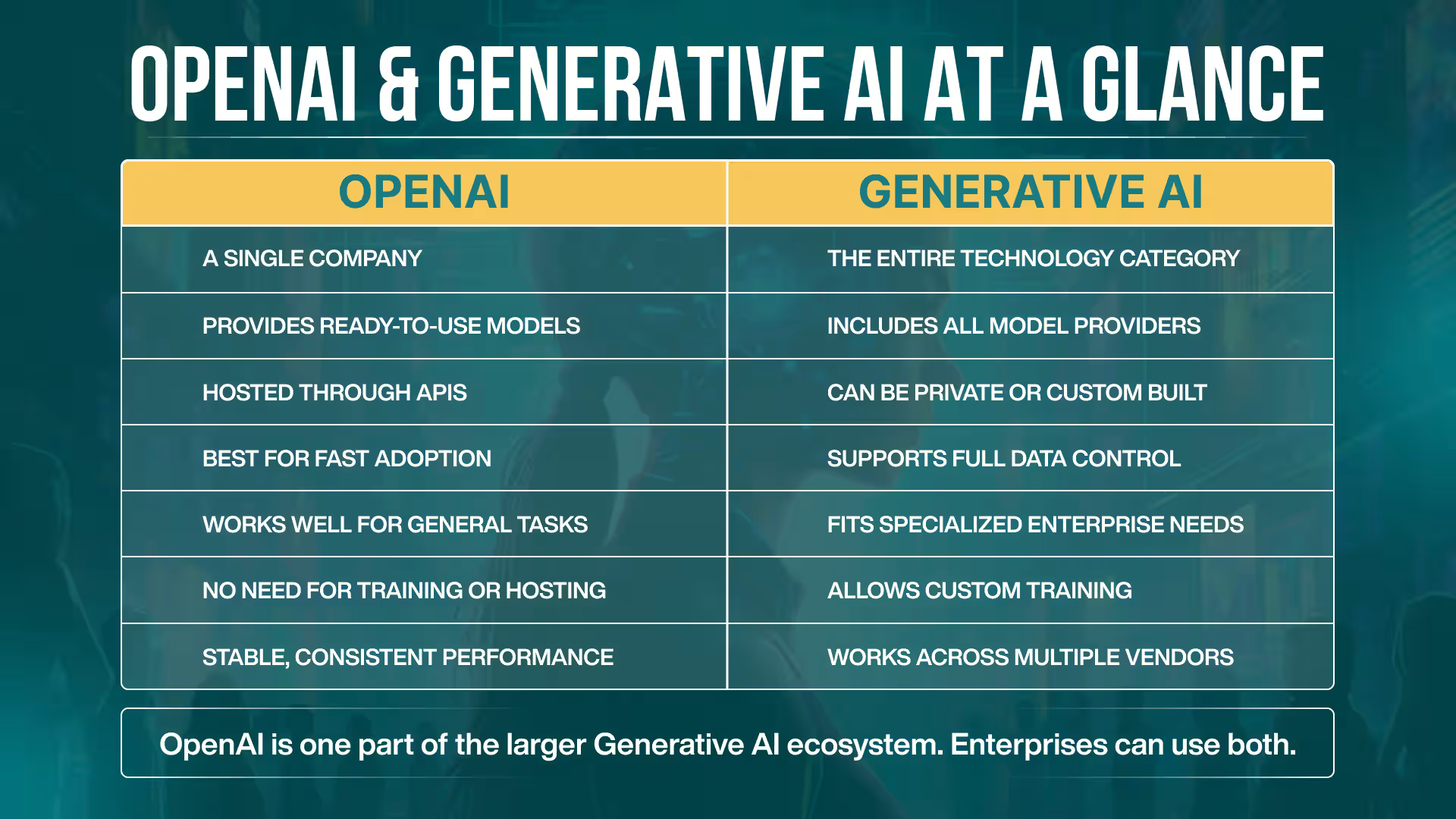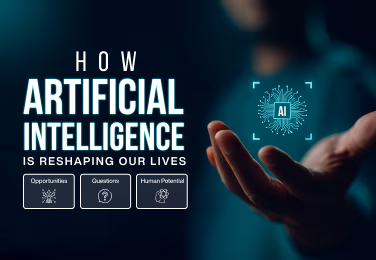

- By ACI
- 18 November, 2025
- 6 min Read
OpenAI vs Generative AI A Clear Guide for Enterprise Teams
Artificial intelligence is now central to how enterprises plan, operate, and deliver services. Many leaders compare OpenAI with the broader field of Generative AI while shaping their technology roadmap. These terms may sound similar, but they represent different concepts. Understanding them helps organizations make better decisions for automation, knowledge management, and enterprise transformation.
This guide explains both concepts in clear terms. It outlines when OpenAI is a strong choice, when the wider Generative AI ecosystem is better, and how Aryabh Consulting Inc. supports enterprise adoption.
Understanding OpenAI and Generative AI
OpenAI is a company that provides specific AI models. Generative AI is a larger scientific and engineering field that includes every model capable of creating new text, images, audio, video, or structured output.
In simple terms, OpenAI belongs to the Generative AI category. It is one provider among many, not a separate technology.
Enterprises use Generative AI for knowledge search, document understanding, code generation, planning, structured insights, and workflow automation. The broader ecosystem includes large language models, multimodal systems, diffusion models, and custom enterprise-trained models.
What OpenAI Provides
OpenAI offers general-purpose models such as GPT and DALL·E. These models are trained on large datasets and made available through easy-to-use APIs. Enterprises often adopt OpenAI first because it provides reliable performance with minimal setup.
1. Ready-to-use enterprise capabilities
OpenAI supports customer assistance, internal knowledge tools, data extraction, document summarization, and operational automation.
2. Fast integration
Teams can embed OpenAI models into existing systems quickly without building new infrastructure.
3. Support for early AI adoption
OpenAI is effective for pilots, productivity tools, and cross-department use cases due to its API-first approach and strong documentation.

Where Generative AI Goes Beyond OpenAI
The broader Generative AI ecosystem supports deeper control, customization, and governance. It includes open-source models, domain-specific models, and private deployments. These options are suitable for teams handling sensitive or regulated data.
1. Custom model training
Enterprises can build models that understand industry language, compliance rules, and domain-specific workflows.
2. Greater security and data control
Organizations can deploy Generative AI in private cloud or on-premise environments for stronger governance.
3. Flexible vendor options
Generative AI allows multi-vendor setups, hybrid workflows, and cost optimization based on usage patterns.
These capabilities help organizations align AI with compliance, scale, and long-term operational needs.
Choosing Between OpenAI and Generative AI
OpenAI supports fast deployment and general reasoning tasks. Generative AI supports deeper customization and privacy. Both choices are valid depending on enterprise requirements.
1. When OpenAI is the right fit
OpenAI works well when teams need quick setup, broad use cases, minimal overhead, and consistent performance across operations.
2. When enterprises need a broader AI strategy
A wider Generative AI approach is suitable for custom models, legacy integration, strict governance, and industry-specific accuracy needs.
3. Hybrid adoption
Many enterprises combine OpenAI with private or open-source models to balance performance, privacy, and cost.
Use Cases Across Both Approaches
OpenAI and broader Generative AI setups support similar use cases. The difference lies in customization. Common enterprise applications include customer assistance, contract management, clinical documentation, claims processing, compliance support, fraud pattern analysis, knowledge retrieval, and complex workflow automation.
Challenges and Enterprise Risks
Successful AI adoption requires proper planning. Enterprises must manage privacy control, data security, hallucination reduction, cost management, vendor dependence, evaluation methods, and change management for teams.
How Aryabh Consulting USA Supports AI Adoption
Aryabh Consulting USA helps organizations choose the right AI approach based on their goals. The team supports multivendor integration, OpenAI implementation, custom model development, architecture design, data governance, workflow automation, and long-term optimization.
ACI remains vendor neutral and focuses on delivering accurate, compliant, and scalable AI solutions.

Frequently Asked Question
1. What is the difference between OpenAI and Generative AI
OpenAI is a specific model provider. Generative AI is the full set of technologies used to create new content and intelligence.
2. Can enterprises use OpenAI and other models together
Yes. Many organizations use OpenAI for general tasks and custom models for sensitive operations.
3. Is Generative AI safe for enterprise use
Yes. Safety depends on the right governance, private deployment, and data handling.
4. Which industries gain the most value from Generative AI
Healthcare, insurance, banking, retail, logistics, and enterprise operations.
5. When should an organization consider custom models
Custom models are suitable for sensitive data, high accuracy needs, or strict compliance environments.
Conclusion
OpenAI and Generative AI are related but serve different enterprise needs. OpenAI focuses on ease of use and fast integration. Generative AI offers deeper control, customization, and privacy. The strongest results come when organizations understand where each approach fits into their roadmap.
Enterprises looking for guidance can connect with Aryabh Consulting USA to design a responsible and effective AI adoption strategy.
